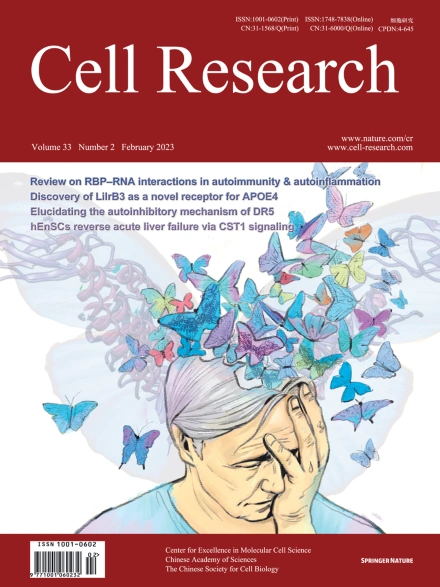
Advanced Search
Submit Manuscript
Advanced Search
Submit Manuscript
Volume 33, No 2, Feb 2023
ISSN: 1001-0602
EISSN: 1748-7838 2018
impact factor 17.848*
(Clarivate Analytics, 2019)
Volume 33 Issue 2, February 2023: 147-164 |
Human endoderm stem cells reverse inflammation-related acute liver failure through cystatin SN-mediated inhibition of interferon signaling
Yilin Xu1,† , Jinglin Wang2,3,† , Haozhen Ren2,3,† , Hao Dai1,4,† , Ying Zhou1 , Xiongzhao Ren1 , Yang Wang5 , Sisi Feng1 , Xiaogang Deng1 , Jiaying Wu1 , Tianlong Fu1 , Tengfei Nie1 , Haifeng He1 , Tongkun Wei1 , Bing Zhu6 , Lijian Hui1 , Bin Li5 , Jing Wang5 , Hongyan Wang1,* , Luonan Chen1,7,* , Xiaolei Shi2,3,* , Xin Cheng1,*
1State Key Laboratory of Cell Biology, Shanghai Institute of Biochemistry and Cell Biology, Center for Excellence in Molecular Cell Science, Chinese Academy of Sciences, University of Chinese Academy of Sciences, Shanghai, ChinaAcute liver failure (ALF) is a life-threatening disease that occurs secondary to drug toxicity, infection or a devastating immune response. Orthotopic liver transplantation is an effective treatment but limited by the shortage of donor organs, the requirement for life-long immune suppression and surgical challenges. Stem cell transplantation is a promising alternative therapy for fulminant liver failure owing to the immunomodulatory abilities of stem cells. Here, we report that when transplanted into the liver, human endoderm stem cells (hEnSCs) that are germ layer-specific and nontumorigenic cells derived from pluripotent stem cells are able to effectively ameliorate hepatic injury in multiple rodent and swine drug-induced ALF models. We demonstrate that hEnSCs tune the local immune microenvironment by skewing macrophages/Kupffer cells towards an anti-inflammatory state and by reducing the infiltrating monocytes/macrophages and inflammatory T helper cells. Single-cell transcriptomic analyses of infiltrating and resident monocytes/macrophages isolated from animal livers revealed dramatic changes, including changes in gene expression that correlated with the change of activation states, and dynamic population heterogeneity among these cells after hEnSC transplantation. We further demonstrate that hEnSCs modulate the activation state of macrophages/Kupffer cells via cystatin SN (CST1)-mediated inhibition of interferon signaling and therefore highlight CST1 as a candidate therapeutic agent for diseases that involve over-activation of interferons. We propose that hEnSC transplantation represents a novel and powerful cell therapeutic treatment for ALF.
https://doi.org/10.1038/s41422-022-00760-5